Orioles are one of the most sought-after birds to attract to your garden. Their bright colors and melodious songs enhance any outdoor activities. They occur naturally in many regions, and most of them migrate yearly. But, what do orioles eat? If you wonder what orioles eat, read to find out what to offer on your garden bird feeder to attract orioles.
Orioles eat brightly colored ripe fruit, flower nectar, insects, caterpillars, caterpillar larvae, wasps, spiders, and worms. They will also eat brambles, flowers, and flower buds. Different oriole species have preferences for foods. They are insectivores, fruitivores and nectivores.

Orioles’ specific diet will be influenced by the food available in the area. They are striking birds, well adapted to the food they eat.
Love birds?
Here’s how to attract birds to your yard:
- what do cardinals eat
- best bird feeders for cardinals
- what do hummingbirds eat
- purple flowers that attract hummingbirds
- red flowers that attract hummingbirds
What Are Orioles?
Baltimore Orioles (Icterus galbula), sometimes just called orioles, are a small icterid blackbird that is common in Eastern North America. They are some of the most brilliantly colored songbirds in the eat, with their flaming orange and black colors easy to see from even a distance away.
In fact, the colors are where it got its name, as they resembled the coat-of-arms of 17th century Lord Baltimore. Orioles are migratory breeding birds, and they can be easily lured to backyards in their area with the right tasty treats and a safe environment.
For this post, we’ll be talking mostly about the Baltimore oriole. However, the diet is very similar for all the different types that are found in the U.S.
What are the different types of orioles?
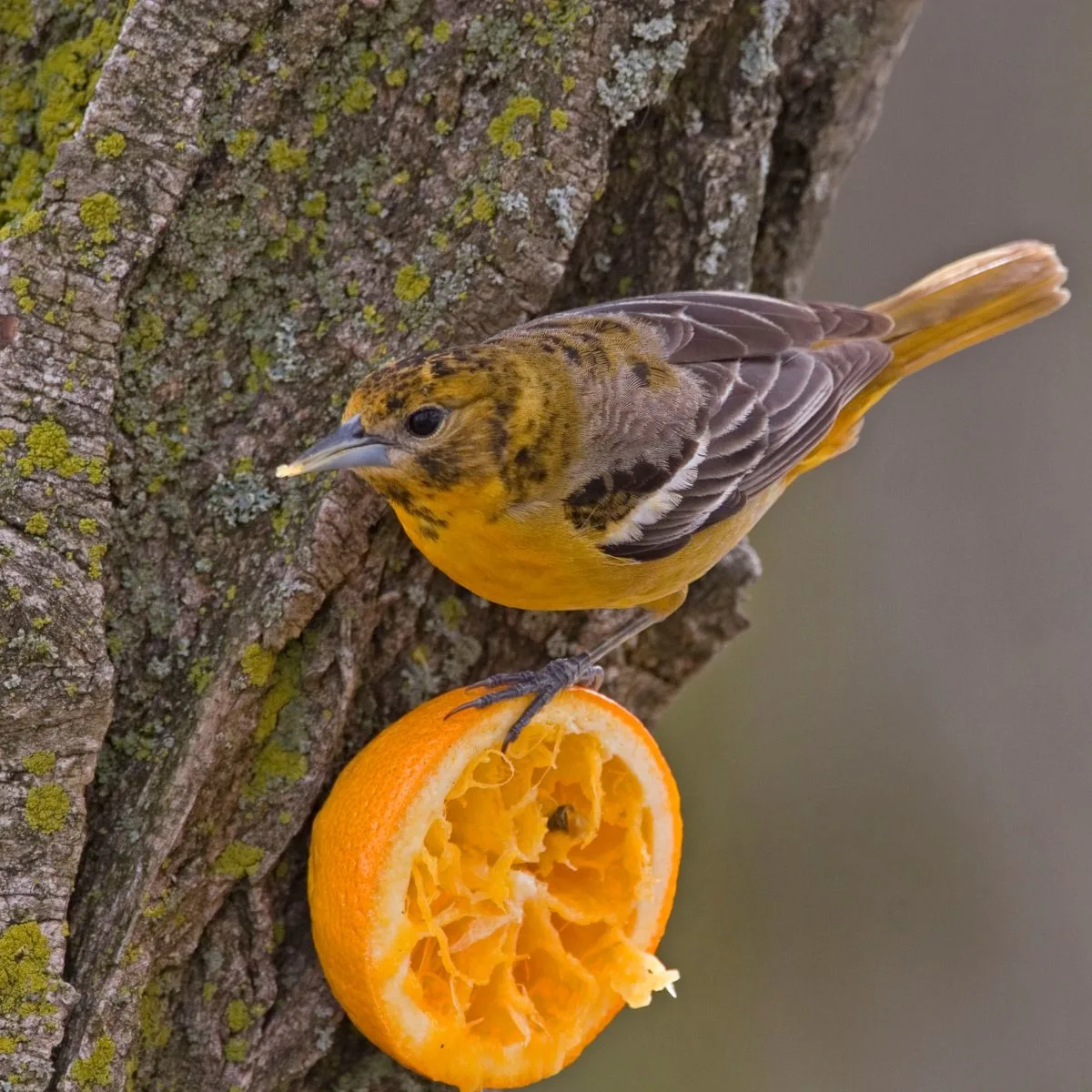
There are eight different types of orioles you may find in the U.S. These include:
- Baltimore orioles
- Orchard orioles
- Hooded oriole
- Bullock’s oriole
- Scott’s oriole
- Altamira orioles
- Audubon’s oriole
- Spot-breasted oriole
What Do Orioles Eat?
To attract these beautiful birds to your garden, start by understanding what they eat. Here’s an overview, and I’ll go into more detail about each below:
- Insects
- Worms/mealworms
- Wasps
- Nectar (commercial brand or homemade)
- Fruits (especially oranges, apples, peaches, berries, and bananas)
- Flowers and buds of flowers
- Suet mixed with fruit, berries, or peanut butter
- Jelly (especially grape and orange)
The exact diet varies according to the type of oriole that you have in your area. All the types of orioles eat insects. Most of them also all eat fruit and berries, and most also eat nectar. Let’s look into this in more detail.
Orioles Love Insects
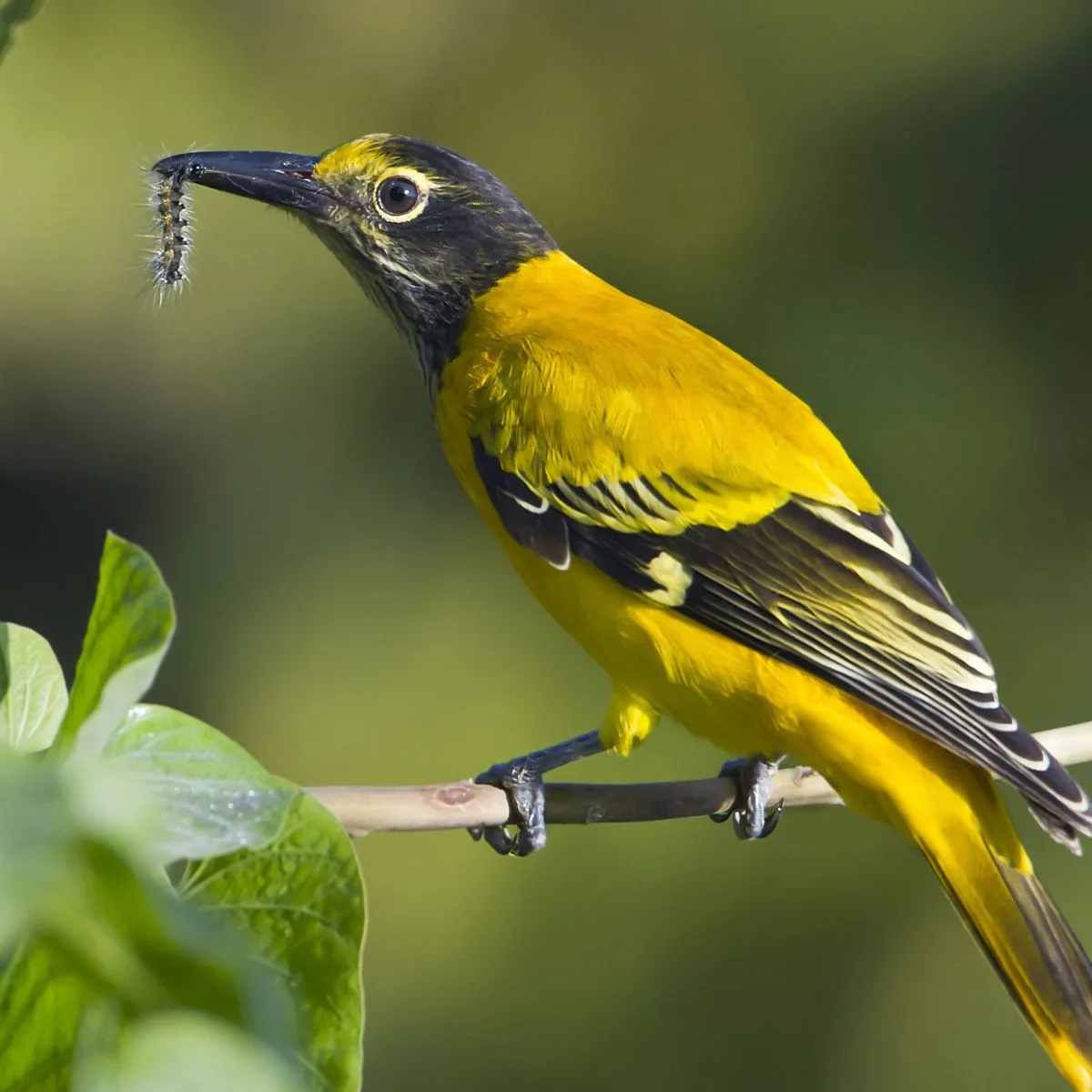
Orioles have strong, sharp, pointed beaks, which allow them to be adept at stabbing and grabbing insects. They will eat most insects and are not afraid to tackle some off-putting insects which other birds avoid.
For example, orioles are known to eat hairy caterpillars that can cause unpleasant irritation from their spines or hairs. Other birds typically avoid these caterpillars, but orioles somehow do not seem affected by these caterpillar defense mechanisms.
Orioles are also happy to tackle wasps and spiders in their quest for food. They are valuable birds as they eat many insect pests such as:
- Fall webworms
- Tent caterpillars (they tear open the web to extract the caterpillar)
- Gypsy moths
They also eat the pupae of many insects, including caterpillars, worms, and wasp species that feed on fruit. Farmers often regard orioles as pests because they eat fruit, but the truth is they are far more helpful in controlling insect pests.
The oriole’s sharp beak allows it to stab into crevices and cracks where insects may be hiding or where insect pupae have hatched. They are acrobatic fliers and often catch insects in midair.
They will also hop around trees and bushes searching for insects taking refuge in the foliage. They are smart and adept hunters able to grab these insects quickly and effectively.
Bullock’s orioles will eat grasshoppers exclusively if they are in plentiful supply. In one survey, it was found that one oriole could eat forty-five grasshoppers in a day. This makes them useful birds that protect crops from insect invasions.
Fruit
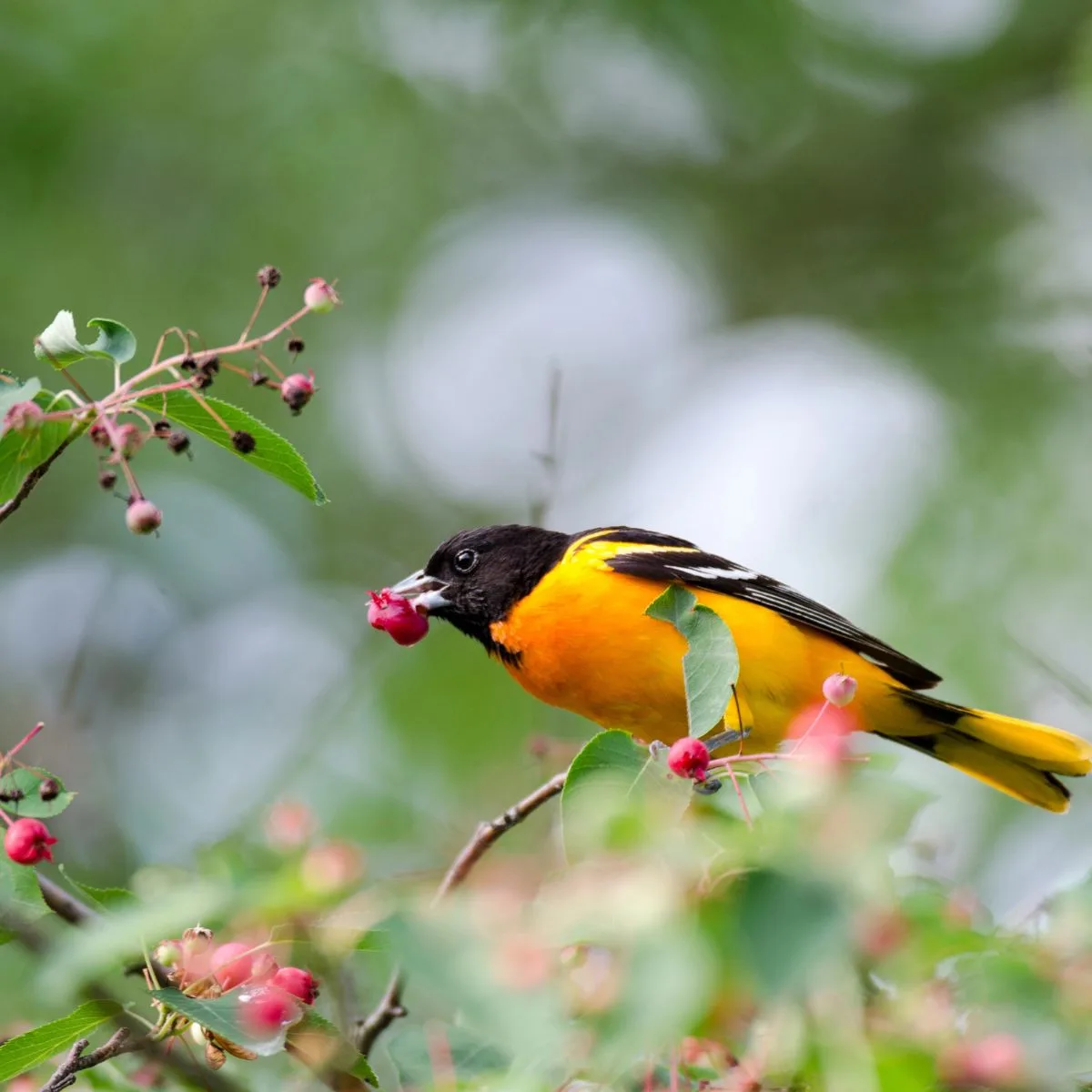
As we said above, yes, they do eat fruit! Orioles are partial to bright or intensely colored fruit. They eat oranges, berries, purple figs, and a host of other fruit. A study showed that they generally only eat ripe fruit and prefer dark colors. Orioles will eat dark purple plums but pass up yellow plums even if they are ripe.
Orioles have an unusual method of eating juicy fruits. It is known as gaping. The oriole stabs its sharp beak into the fruit and then opens its beak allowing the juices to run directly into its mouth. It’s really interesting to see if you ever get the chance to witness it in action.
Orioles primarily eat fruit in spring and early summer to gain energy after their long migratory flights. Once they begin nesting and have young to feed, they change to eating mainly insects.
When orioles migrate to their winter regions, they feed primarily on fruit and nectar, supplying them with energy-rich sugars.
Nectar
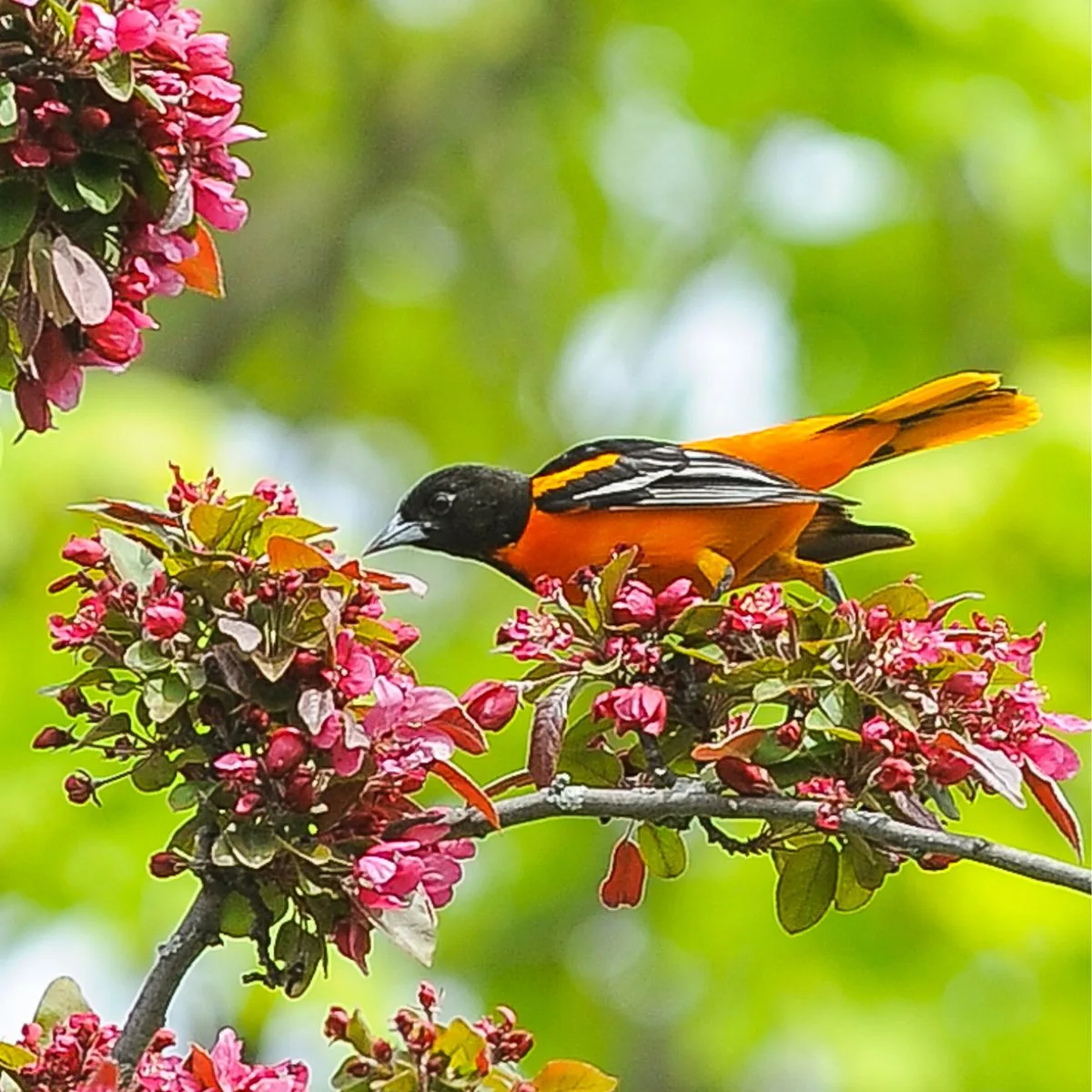
Orioles are attracted to flowers and can be found dipping their beaks into flowers to access the nectar. They cannot hover like hummingbirds and must perch on a convenient twig or branch to get their beaks into the flower.
Many insects are attracted to flower nectar. The orioles make the most of this, enjoying a sip of sweet nectar while also getting their protein intake from the insects in the flowers. Orioles may sometimes also eat flowers or flower buds.
How Do I Attract Orioles to My Garden?
Orioles have different nutritional needs at differing times of the year. They prefer fruit and nectar during spring and late fall, giving them extra energy to recover from or prepare for migration. During the breeding season, orioles eat insects to ensure a protein-rich diet.
Here are some ways you can attract orioles to your garden:
- Choose foods they will REALLY eat
- Use oriole-friendly feeders
- Choose seasonal foods when attracting them
- Provide clean, fresh water
- Plant native trees and plants that orioles love
How to encourage nesting in your yard
Orioles are also known for making some of the most complicated nests of any bird species. When you make it easier for them to nest, they are more likely to do so in your yard. You can help encourage nesting by leaving pieces of biodegradable string and yard in 6-inch pieces or short. You can place them in a suet feeder, and the birds will find them.
Are orioles attracted to the color orange?
Yes! Another trick you can use is to use the color orange in and around your landscape. You can use flags, flowers that bloom orange, or other lawn ornaments in orange, and orioles will be attracted to it.
What bird feeder can I use for orioles?
Orioles seem to have a fascination with orange. Painting your bird feeder orange or purchasing an orange bird feeder will catch the attention of any neighborhood orioles and entice them into paying a visit.
There should be a place for them to perch to feed. The best feeders can spike fruit, a nectar receptacle, and a bowl for insect offerings.
What fruit should I offer orioles?
Oranges that are sliced, halved, or quartered can be attached to the bird feeder. This makes the bird feeder wildly popular with orioles. You can provide almost any other fruit if it is ripe, but darker-colored fruits are preferred.
Plums, berries, grapes, and soaked raisins are firm favorites. Some people soak apples and bananas in grape juice to add color and offer this. Orioles attracted by dark-colored fruit or oranges may learn to eat bananas and apples even though they are not intensely colored.
How can I offer insects to orioles?
Mealworms make an easy and cheap means of offering insects for orioles to eat. They can be purchased from many pet shops or fishing bait shops, and you can even breed some in a worm bin in your backyard.
Place some mealworms in a container on the bird feeder. You should provide some bran or vegetable peelings for the mealworms to eat and hide under while they are in the container. Mealworms do not like to be out in the open and will make a hasty exit if uncovered and can get out of the container.
Only put a few vegetables or bran in the container so the orioles see the worms moving beneath the surface. The orioles will soon find the worms, and once they are accustomed to expecting the worms, they will eat all the worms you can supply.
How do I offer nectar to orioles?
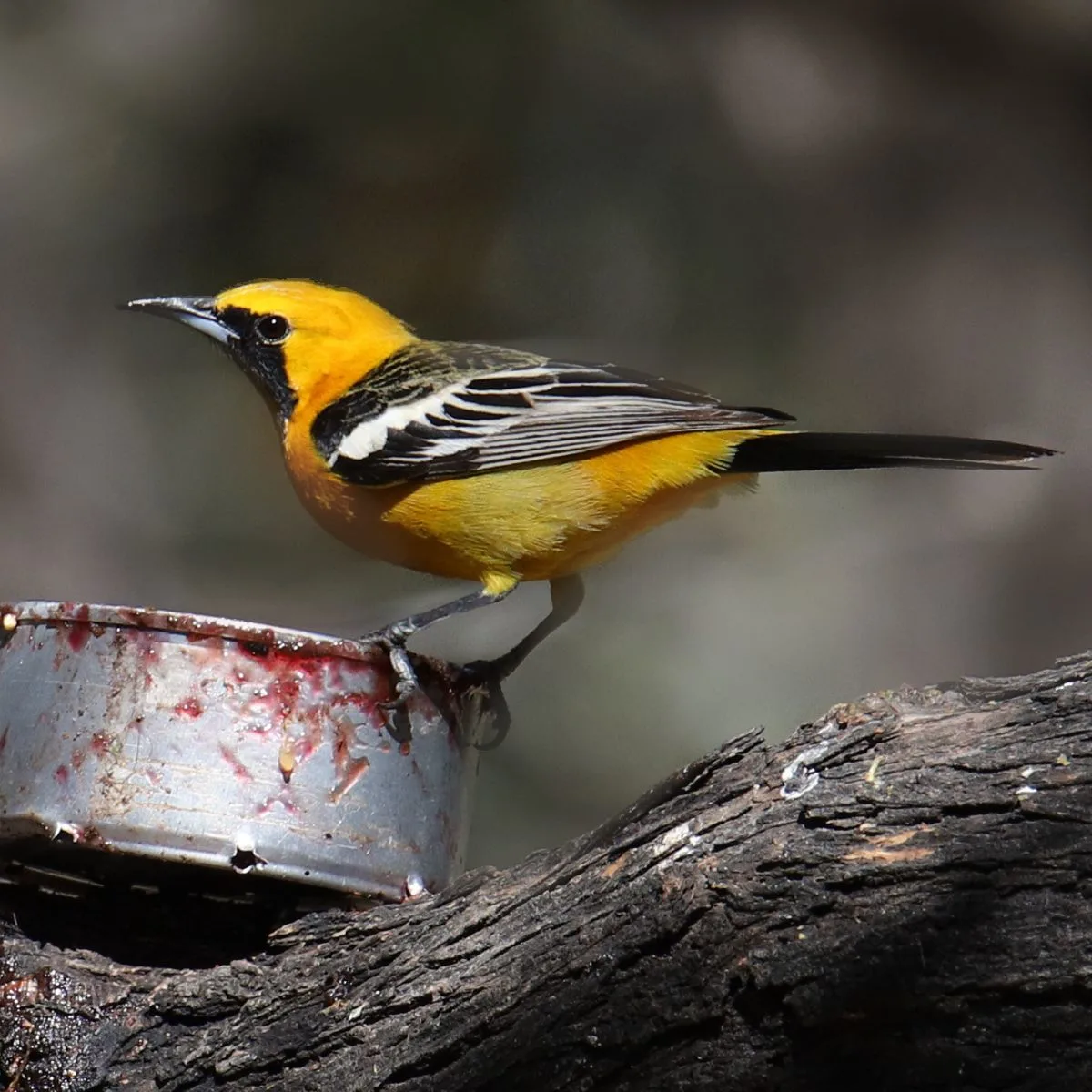
Many nectar feeders are available for purchase, or you could use a shallow dish. Use a sugar-water nectar mix to make a thick syrup.
Grape jelly is another popular offering in the nectar dish. You can offer the grape jelly as it comes or mix one part jelly with an equal part water to make a syrup. If you use grape jelly, ensure it has no artificial sweeteners, colorants, or preservatives.
What Plants Will Attract Orioles to My Garden?
Mulberries, blackberries, serviceberries, brambles, and crab apples attract orioles. Any plants bearing nectar-rich flowers will be suitable for orioles. These include zinnias, salvias, larkspur, columbines, and dahlias.
Trees that attract nectar-feeding birds include:
- Maple
- Wild black cherry
- Flowering dogwood
- Sweet birch
- American holly
Additional Tips for Feeding Orioles
In addition to all of the above, here are some other tips you can consider when feeding orioles and trying to attract them to your lawn or garden:
- Don’t use pesticides or insecticides – this removes insects that the birds eat
- Plant a variety of brightly colored, nectar-providing flowers in your garden
- Protect your feeders from ants with something like ant moats
- Keep feeders fresh and clean and check them daily
- Never offer sodas, fortified orange juice, or flavored drinks in place of nectar
- Plant shrubs and bushes with berries that orioles like – blackberries, raspberries, etc.
In Conclusion
As you can see from this post, there are so many great reasons you may want orioles around your lawn or garden. And there are also many great ways to attract them to your lawn or garden. Don’t get discouraged if you don’t see them showing up right away. It could take a season or two, or even up to a couple of years, for them to realize you are a good source of food and safety for them.
Also, remember where you live in relation to their migratory patterns. However, the tips above should help you learn more about what orioles eat and also how to attract them to your garden and lawn if you want to. Do you have orioles in your yard already? What do they love to eat?
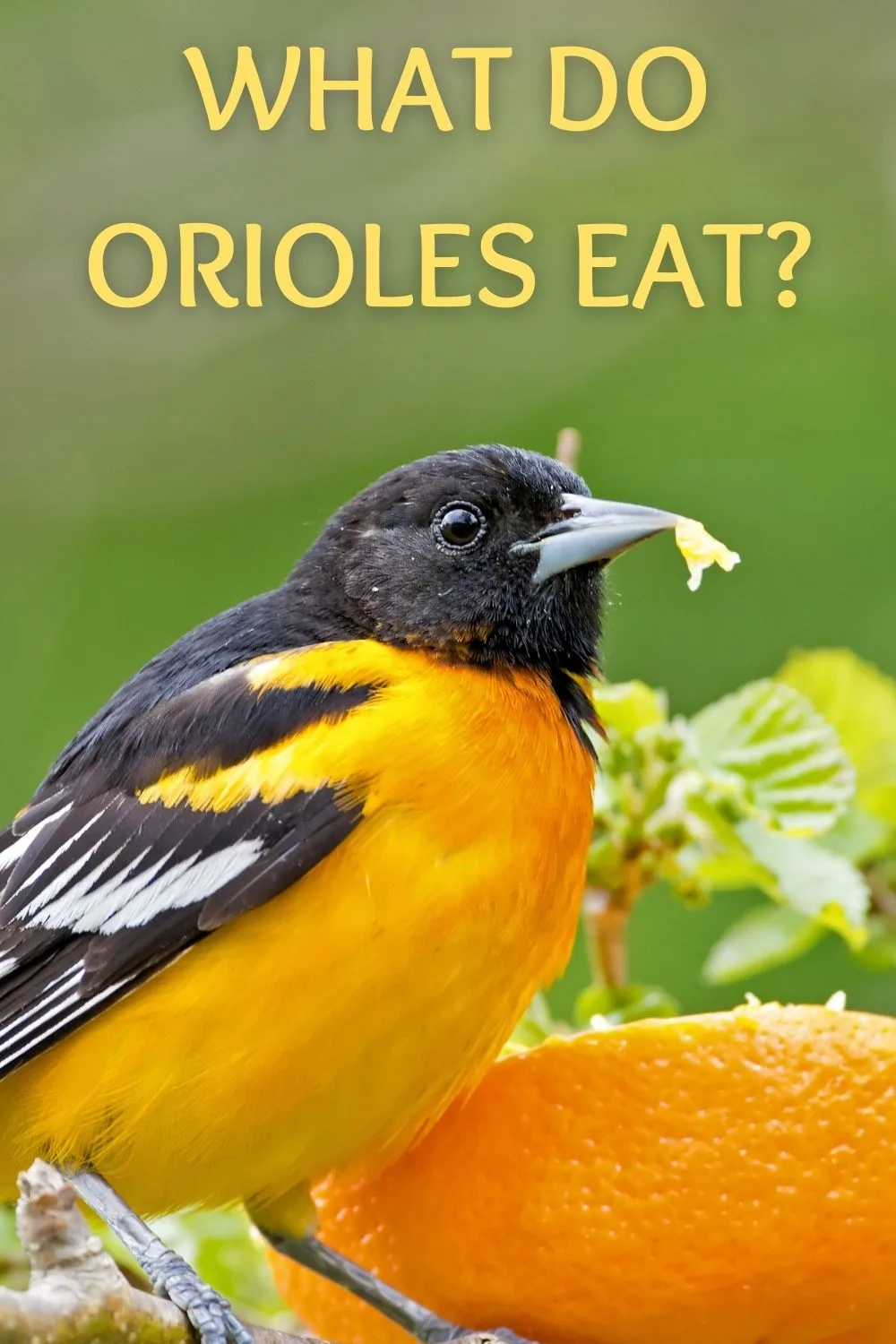
Adriana Copaceanu is a passionate nature lover living in the country on her dream property where she grows vegetables, lavender, and wildflowers that she shares with the wildlife they attract. When she's not in the garden, she loves spending time with her chickens and planning her next nature project. Check out her books below:
How to Grow Lavender for Fun and Profit: Lessons Learned from Planting Three Hundred Lavender Plants




What Do Cardinals Eat? Easy Ways To Attract Them To Your Yard
Tuesday 23rd of August 2022
[…] what do orioles eat? […]